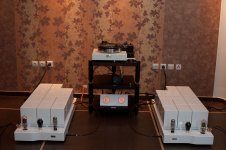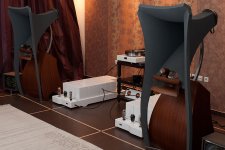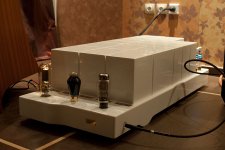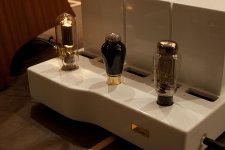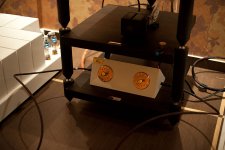JC Morrison's recent effort is worth inspecting too:
some interesting dc circuits
some interesting dc circuits
I know this is an "old" thread but your amps are timeless....
Congratulations Peter with your drive to go that extra mile...I myself know the feeling...
I also admire your patience towards a few typical average posters whose remarks are with dubious intention to say the least...clearly you are miles ahead of them......I would love to read more of your projects...links are more than welcome...
Thanks Dimitris to point Peter out to me
Congratulations Peter with your drive to go that extra mile...I myself know the feeling...
I also admire your patience towards a few typical average posters whose remarks are with dubious intention to say the least...clearly you are miles ahead of them......I would love to read more of your projects...links are more than welcome...
Thanks Dimitris to point Peter out to me
I know this is an "old" thread but your amps are timeless....
Congratulations Peter with your drive to go that extra mile...I myself know the feeling...
I also admire your patience towards a few typical average posters whose remarks are with dubious intention to say the least...clearly you are miles ahead of them......I would love to read more of your projects...links are more than welcome...
Thanks Dimitris to point Peter out to me
Hello Erik!
I would like to thank you for your kind words from deeply inside my heart!
It is these words that give me the guts to go ahead, to travel the extra mile, exactly as you write.
A few years ago I have decided to materialize some projects. All of them are trully unique projects, unique in every aspect. Some of them are absolutely crazy, totally out of this world. Those are creations of imagination when boundaries of cost, labor hours and creativity do not apply! For all those projects, sky is the only limit.
There are several more exotic projects coming. I have already manufacured two crazy prono preamplifiers, pictures of which are going to come shortly. I hope that by year's end they are going to be demonstrated at Nikos' house, along with those 167-kgs-per-monoblock-chassis white power amplifiers. And the world's first crazy MC step up transformer at a ratio of 80x, specially designed for those exotic MC cartridges with output of less than 0.1mV.
Stay tuned...
All the best from Athens, Greece!
Last edited:
First of all, great work, Petavgeris! Exotic to the max.
Any tips on working with ultra-HEAVY amplifiers? I'm currently building one that should be just under 100kg and am wondering how best to deal with that weight while finishing up the build - of course, I'm leaving the heaviest pieces to last so I don't have to lift them every time I flip the amp, but perhaps you have some other insights for us?
Any tips on working with ultra-HEAVY amplifiers? I'm currently building one that should be just under 100kg and am wondering how best to deal with that weight while finishing up the build - of course, I'm leaving the heaviest pieces to last so I don't have to lift them every time I flip the amp, but perhaps you have some other insights for us?
Simply beautiful work!
Petavgeris, can you tell us about the turntable on the top of the equipment stand? Is the base also made of Corian? What type of phono stage?
I am also curious about what appears to be a passive volume attenuator on the bottom shelf. Does that use autotransformers and if so did you wind them yourself?
Petavgeris, can you tell us about the turntable on the top of the equipment stand? Is the base also made of Corian? What type of phono stage?
I am also curious about what appears to be a passive volume attenuator on the bottom shelf. Does that use autotransformers and if so did you wind them yourself?
Hello Erik!
There are several more exotic projects coming. I have already manufacured two crazy prono preamplifiers, pictures of which are going to come shortly. I hope that by year's end they are going to be demonstrated at Nikos' house, along with those 167-kgs-per-monoblock-chassis white power amplifiers. And the world's first crazy MC step up transformer at a ratio of 80x, specially designed for those exotic MC cartridges with output of less than 0.1mV.
Stay tuned...
All the best from Athens, Greece!
Should be fun to read..I am no stranger to "weight" with my 100 kg pre amp and 80 kg cd transport 250 kg speakers etc.
Made all the stuff but only for myself......
I will stay tuned...bring the building links on.....
Have fun with my DIY contribution...
Hi There...My homebuild stuff
Simply beautiful work!
Petavgeris, can you tell us about the turntable on the top of the equipment stand? Is the base also made of Corian? What type of phono stage?
I am also curious about what appears to be a passive volume attenuator on the bottom shelf. Does that use autotransformers and if so did you wind them yourself?
Hello!
The turntable on top is a classic Verdier painted in white color. The phono stage is 47 labs modified in its power supply. The 'table is also modified. All mods were performed by the owner, who is also the manufacturer of this nice wooden rack.
The preamp is nothing more than a mere carbon film attenuator of maximum quality. Several autoformers had been evaluated as the owner was not that supportive of the 'pot' idea. He actually owned probably the best ones evaluated, but again they sounded inferior to this carbon pot.
This passive preamp is a preliminary model, a temporary solution. It is going to be replaced by the most insane autoformers pair ever developed, with custom designed and manufactured ferromagnetic alloy as tape wound c cores, with a huge power supply to energize the magnetic field inside these transformers. Unfortunately, these creations take a really looong time to reach maturity, so we try to keep patience. In the end, patience always pays back!
Hello,
Knowing how much dedication and focus it sometimes takes to complete even the simplest of projects, I can only look on in awe and admiration. Beautiful, in both look and process.
Can I ask, are you using the multi-split bobbins for both your output/interstage transformers and chokes? There is a short video I have seen about Kondo and the Ongaku amplifier that shows a 'technician' winding on a multi-split bobbin. I have always wondered which component he was winding, and whether a secret was inadvertently being given away.
Simon
Knowing how much dedication and focus it sometimes takes to complete even the simplest of projects, I can only look on in awe and admiration. Beautiful, in both look and process.
Can I ask, are you using the multi-split bobbins for both your output/interstage transformers and chokes? There is a short video I have seen about Kondo and the Ongaku amplifier that shows a 'technician' winding on a multi-split bobbin. I have always wondered which component he was winding, and whether a secret was inadvertently being given away.
Simon
Hello,
Knowing how much dedication and focus it sometimes takes to complete even the simplest of projects, I can only look on in awe and admiration. Beautiful, in both look and process.
Can I ask, are you using the multi-split bobbins for both your output/interstage transformers and chokes? There is a short video I have seen about Kondo and the Ongaku amplifier that shows a 'technician' winding on a multi-split bobbin. I have always wondered which component he was winding, and whether a secret was inadvertently being given away.
Simon
Simon,
thank you very much for your kind words. This was a really tough project but the most tough are still ahead
The split bobbins that you mention, as well as all the bobbins on these amps are hand made. They are cut on a precision laserject machine and then hand assembled and glued alltogether. They are designed so as the c cores fit with maximum tolerance and virtually no space is left.
The number of the sections is calculated and the space occupied by copper wire is the ideal for each application. I did not know that Kondo OPTs are sectioned. My ISTs seem to be 'plain' multi-sectioned, wound on split bobbin coil formers, though reality is not exactly this. I apologize for not being able to give out more information on ISTs.
Nothing is actually a 'top secret' in SET arena, the technology has been squeezed to its limits since many decades ago. In theoretical terms. As soon as I am the designer and manufacturer of this amp project from scratch, all I have to say is that it is not the technology that suffers when the result is not up to the task, it is the application of the rules that suffers. Whoever designs SET amps has to depend on the quality of iron pieces, name it P/S, IST, OPT transformers or inductors. This is the limitation of SET design. In order to travel the extra mile, you must wind the iron pieces yourself, as all products suffer from very serious flaws. Trust me, I know what I am writing of... I see some ISTs around, small like an appricot, terribly executed, sold for several thousand dollars, because they are made of special material and varnished with snake oil...
Have a nice day!
"167-kgs-per-monoblock-chassis", are you sure you are not a civil engineer?
Yeah, prrtty sure...
I have studied mechanical engineering: -)
Simply beautiful work!
Petavgeris, can you tell us about the turntable on the top of the equipment stand? Is the base also made of Corian?
Here is a closer look at the turntable. As Peter said, the owner (Nick-Jadisboy) has made many mods to the table including a custom flywheel made out of his signature graphite material.
An externally hosted image should be here but it was not working when we last tested it.
It is a miracle amp, for lovers of miracles. Of course, the price should include insurance enough to cover an accidental death of the owner, his family members or guests, or pets.
Nice peace of jewelry. Dangerous, though...
Almost all DiY projects are accidents waiting to happen. This advice falls into the do as I say, not as I do category.
Any project that includes tubes really should have the beasts caged. VTs, especially power VTs, get finger burning hot, and external caps often present shock hazards. Even small signal types get unexpectedly hot. You'd think that the sight of a red hot bar of metal in there would clue them in, but it often doesn't.
You're not completely out of the woods with SS. Powerful SS amps operate their finals ~50VDC or more. That may not seem like much, but a 50V rail can be a shocking experience, and transistors usually have their collectors/drains connected to exposed metal. If it's a +/- rail you could get hit with 100V+, and that is definitely dangerous. And let's not forget heat sinks and how hot they can get.
I didn't do that with my projects since I know where the high voltage is, I don't have kids, and keep the pets out of the listening room. (Cats, especially, like to snuggle up to warm things.) I don't play them when I have guests over unless they specifically request to hear them, and that's an occasion for a mini electrical and thermal safety lecture before power-up. If there are kids present, no way!
Of course, you can do everything right, and have something go wrong. The fool is always greater than the proof, and you can't always anticipate something like a tipsy guest spilling a whole can of ice cold beer into the circuitry: exploding bottles and fireworks. Never had it happen, but I've heard from those who have. You just have to hope your third wire safety grounds and fuses/circuit breakers do their jobs.
+1 ,make it 12 pagesSo far we have gotten to 6 pages, without a single circuit diagram, tech spec or even an underside view of the amplifier!

Mona
Any project that includes tubes really should have the beasts caged. VTs, especially power VTs, get finger burning hot, and external caps often present shock hazards. Even small signal types get unexpectedly hot. You'd think that the sight of a red hot bar of metal in there would clue them in, but it often doesn't.
Sorry, but your posting seems to be totally out of concept!
If you think that this kind of amplification device is not for you, you can step aside.
If you feel afraid of being hurt or injured, stay away of such machines.
If you feel that driving a car can be potentially dangerous, don't drive it, otherwise there are always chances that somebody will run against you.
If you think that a knife is a dangerous tool, don't use it to cut your salad.
If you think that lighter is a dangerous tool and it may explode, don't use it!
Simple, isn't it?
- Status
- This old topic is closed. If you want to reopen this topic, contact a moderator using the "Report Post" button.
- Home
- Amplifiers
- Tubes / Valves
- Most exotic SET power amplifier
